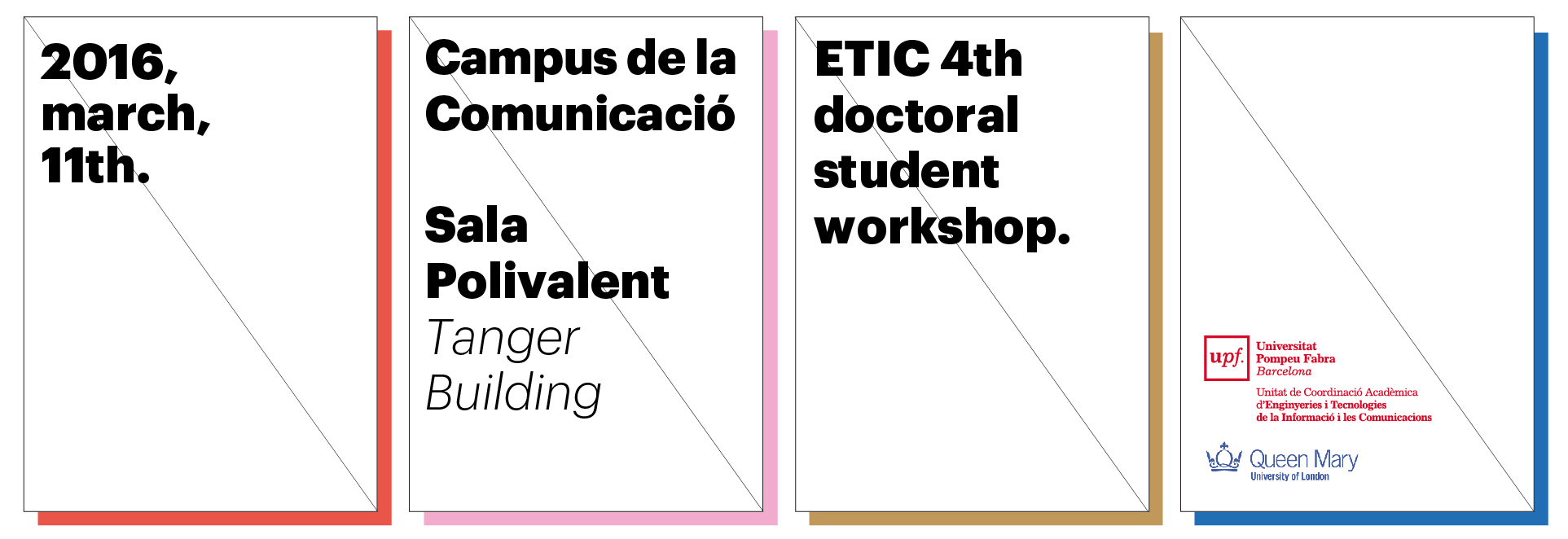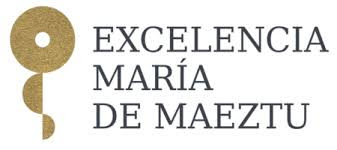DSW2016

The 4th DTIC Doctoral Student Workshop took place on March 11th, 2016. Students from Queen Mary University of London were invited to take part in the event. The list of posters (in alphabetical order of first name) presented was the following:
| Research group & code number | Name | Title |
| CBC-LCC 9 | Alexandre Celma Miralles | Top-down effects of meter induction on audition and vision. |
| GTI 13 | Amit Laxman Ahire | Interactive Character Animation With Hybrid Approach |
| QMUL 60 | Astrid Bin | Doing it Wrong: Towards an understanding of the roles of error, risk and fiasco in DMI design for performance |
| CNS-CRM 36 | Bernat Rovira Olivé | Basins of attraction in neural networks: A computational study |
| BERG 16 | Borja Mercadal | Electroporation and nerve stimulation |
| Physense 30 | Bruno Paun | Quantification of the Internal Elastic Laminae of Blood Vessels in Marfan Syndrome Mice |
| Physense 14 | Cecília Nunes | Learning from uncertain data: A decision tree approach |
| CMTECH 10 | Ciera Crowell | A Full-body Interaction Virtual Environment for Promoting Social Behaviors in Children with Autism |
| QMUL 65 | Daniel Gabana Arellano | Measuring Affective, Physiological and Behavioural Differences in Solo, Competitive and Collaborative Games |
| SPECS 66 | David Cabrera Dalmazzo | Developing BrainX3: Defining, filtering and visualizing temporal activity in human brain network dynamics using an interactive application. |
| CBC-CNS 56 | David Fernandez Bosman | Inferring the underlying frequencies of the brain at rest from a realistic anatomically-constrained network of spiking neurons. |
| Physense 22 | David Soto-Iglesias | Validation of myocardial tissue characterization in MRI with ex-vivo human histological data. |
| SPECS 51 | Diogo | Locomotion modulates functional changes in neural circuits responsible for the integration of internal and external sensory information during spatial navigation. |
| CMTECH 32 | Dmytro Derkach | Facial analysis from emotions to action units using facial curves |
| Physense 43 | Federica Sacco | Effects of the detailed ventricular anatomy on the blood flow |
| CBC-CNS 50 | Federico Devalle | Solvable model for a network of spiking neurons with fixed delays |
| AI 53 | Filippos Kominis | On-line Planning with Nested Beliefs |
| QMUL 19 | Francisco Rodríguez-Algarra | Intelligent Machine Music Listening: An Experimental Approach |
| IP4EC 7 | Gabriela Ghimpeteanu | Local denoising applied to RAW images may outperform non-local patch-based methods applied to the camera output |
| CBC-SPB 34 | Gabriele Cattaneo | Between and within language control in Parkinson’s disease |
| MTG 41 | Georgi Dzhambazov | Keyphrase spotting of lyrics in acapella recordings using probabilistic modeling |
| QMUL 62 | Gnostothea-Veroniki Morfi | Automatic Machine Transcription of Wildlife Bird Sound Scenes |
| NTSA 46 | Irene Malvestio | Detecting unidirectional couplings between point processes |
| TALN 6 | Joan Pere Sánchez Pellicer | Synchronized Oral and Visual Speech generation for Virtual Humans |
| AI 61 | Jonathan Ferrer-Mestres | Combined Task and Motion Planning with Classical Planners Off the Shelf |
| SPECS 52 | Jordi-Ysard Puigbò | Learning by Conditioning: A Computational Model of the Amygdala |
| CBC-CNS 55 | Jose M. Esnaola | Modes of synchronous oscillations of spiking neuron networks. |
| MTG 49 | Juanjo Bosch | Melody extraction in symphonic music recordings: dataset, method and visualisation tool |
| SPECS 20 | Klaudia Grechuta | Visuotactile integration modulates motor performance in a perceptual decision-making task |
| GTI 21 | Laia Albó | Authoring and analytics support of blended learning design with MOOCs and MOOC videos |
| BERG 48 | Laura Becerra Fajardo | Injectable 2 mm Thick Microcontrolled Stimulators Based on Rectification of High Frequency Currents |
| TALN 31 | Luis Espinosa Anke | ExTaSem! Extending, Taxonomizing and Semantifying Domain Terminologies |
| QMUL 66 | Luwei Yang | Automatic Expressive Feature Analysis |
| SPECS 59 | Maria Blancas | Effects of the robot’s characteristics in a HRI educational scenario |
| QMUL 47 | Maria Panteli | Automatic detection of outliers in world music collections |
| WRG 24 | Maria Rauschenberger | German Language Adaption of a Game that Improves the Spelling of Children with Dyslexia |
| CMTECH 5 | Marie-Monique Schaper | RETHINKING MOVEMENT FOR FULL-BODY INTERACTION: A COMPARISON STUDY OF THREE CHILD-CENTERED DESIGN APPROACHES |
| Physense 18 | Marta Nuñez Garcia | Left ventricular morphological analysis of the fetal growth restriction patients |
| SPECS 40 | Martina Maier | Virtual reality rehabilitation for patients with spatial neglect |
| SIMBioSys 4 | Mirella López Picazo | Modelling the lumbar spine for osteoporosis diagnosis |
| TALN 2 | Mónica Domínguez | Acoustics and Linguistics: The Natural Blend for Expressive Speech in Human-Machine Interaction. |
| CREAL 57 | Natàlia Vilor-Tejedor | Novel analytical strategies to assess potential associations in Imaging Genetic studies of childhood Attention-Deficit/Hyperactivity Disorder symptoms and neurocognition |
| SIMBioSys 3 | Nerea Mangado | Patient-specific virtual insertion of electrode array for electrical simulations of cochlear implants |
| SIMBioSys 37 | Oualid Benkarim | Multiatlas segmentation of brain Magnetic Resonance images using spatial confidence maps |
| AI 45 | Oussam Larkem | Social Games, Bounded Rationality and Query Complexity. |
| QMUL 58 | Pablo A. Alvarado | Physically-Musically Inspired Probabilistic Models for Audio Content Analysis |
| AI 44 | Pablo Aragón | Boosting Online Democracy through Social Computing |
| CBC-SAP 28 | Pallabi Sengupta | Traces of Statistical Learning in Brain's Functional Connectivity after Linguistic Processing |
| IP4EC 11 | Praveen Cyriac | Optimized tone curve for in-camera image processing. |
| BERG 33 | Quim Castellví | Liver Conductivity Control by Means of Hypersaline Infusion |
| IP4EC 12 | Raquel Gil | High quality video in high dynamic range scenes from interlaced dual-ISO footage |
| UbiCALab 25 | Raúl Parad Medina | Industrial deployment of an RFID spring-based antenna |
| QMUL 35 | Robert Jack | Building self-contained digital musical instruments with active tactile feedback using Bela embedded audio platform |
| GPI 64 | Roberto P. Palomares | How to improve local optima of optical flow energies using discrete matches |
| Physense 23 | Rubén Doste | Computational electrophysiology for prediction of the outflow tract origin in idiopathic ventricular tachycardia |
| SIMBioSys 39 | Sara Noureldin | An electromagnetic-based navigation system for colonoscopic interventions |
| TALN 42 | Sara Rodríguez Fernández | Example-based Acquisition of Lexical Resources for Second Language Learning |
| TALN-MTG 29 | Sergio Oramas & Luis Espinosa-Anke | Music Meets NLP: Datasets and Challenges |
| SIMBioSys 1 | Sergio Sánchez | Can machine learning help to identify heart failure with preserved ejection fraction? |
| QMUL 38 | Siying Wang | Robust and Efficient Joint Alignment of Multiple Musical Performances |
| IP4EC 17 | Syed Waqas Zamir | Gamut Extension for Cinema: a New Algorithm, and the Need for Psychophysical Evaluation |
| GPI 63 | Vadim Fedorov | Affine Invariant Self-Similarity for Exemplar-Based Inpainting |
| SIMBioSys 54 | Veronika Zimmer | Multimodal Image Registration with Laplacian Commutators |
| Prof. Jorge Lobo 27 | Windhya Rankothge | Data Modelling for the Evaluation of Virtualized Network Functions Resource Allocation Algorithms |
The event was sponsored by the following institutions.




